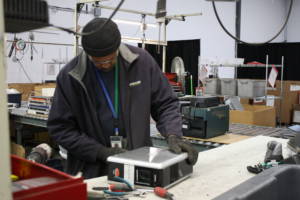You’ve probably seen grainy surveillance video of battery-operated electronics exploding or catching on fire – whether it’s an e-cigarette burning in a person’s pocket or a hoverboard lighting up the inside of a living room.
Those fires are typically caused by the battery – a lithium-ion battery – that is in many of our daily-use devices.
And while those frightening videos of explosions and fires aren’t the statistical norm, we can all probably do a better job of considering what happens to electronics after we’re done with them – either at the end of the lifecycle or because the next best thing has arrived.
I’ll be the first to admit I never thought about it until I visited the Indianapolis processing facility for Cascade Asset Management earlier this year for a story in BizVoice® magazine and got a crash course in how any number of computers, televisions, phones and other electronic detritus is disposed of or recycled. (You can read that story here.)

The company (headquartered in Wisconsin) was recently included in a Washington Post story about the dangers of disposing of electronics, particularly the battery components.
As we enter new-gadget buying season, spare a moment to meet the people who end up handling your old stuff. Isauro Flores-Hernandez, who takes apart used smartphones and tablets for a living, keeps thick gloves, metal tongs and a red fireproof bin by his desk here at Cascade Asset Management, an electronics scrap processor. He uses them to whisk away devices with batteries that burst into flames when he opens them for recycling.
One corner of his desk is charred from an Apple iPhone that began smoking and then exploded after he opened it in 2016. Last year, his co-worker had to slide away an exploding iPad battery and evacuate the area while it burned out.
The root of the problem: volatile lithium-ion batteries sealed inside our favorite electronics from Apple, Samsung, Microsoft and more. They’re not only dangerous but also difficult to take apart — making e-waste less profitable, and contributing to a growing recycling crisis.
These days, rechargeable lithium-ion batteries are in smartphones, tablets, laptops, ear buds, toys, power tools, scooters, hoverboards and e-cigarettes.
For all their benefits at making our devices slim, powerful and easy to recharge, lithium-ion batteries have some big costs. When crushed, punctured, ripped or dropped, lithium-ion batteries can produce what the industry euphemistically calls a “thermal event.” It happens because these batteries short circuit when the super-thin separator between their positive and negative parts gets breached. Remember Samsung’s exploding Note 7 smartphone? That was a lithium-ion thermal event.
Old devices end up in trouble when we throw them in the trash, stick them in the recycling bin, or even responsibly bring them to an e-waste center. There isn’t official data on these fires, but the anecdotal evidence is stark. In California, a recent survey of waste management facilities found 83 percent had at least one fire over the last two years, of which 40 percent were caused by lithium-ion batteries.
Statistically, the fire rates are low — 1 out of 3,000 mobile device batteries that Cascade handles experiences a thermal event. But when batteries spark other material, the result can be catastrophic. In 2016, the Shoreway Environmental Center that serves Silicon Valley suffered a 4-alarm fire it suspects was caused by a lithium-ion battery that went undetected amid other junk in its sorting systems. The fire damage cost $8.5 million.
There’s plenty of blame to go around. People shouldn’t carelessly throw battery-powered electronics into the bin. (Here’s what you should do.) Local governments haven’t figured out good ways for us to hand off of this common but dangerous material. The tech press (including me) should write less about shiny new things and more about how to make old stuff last longer. Some gadget makers, including Apple, are taking steps to make recycling easier.
But ultimately, this is an environmental problem of the tech industry’s own design. And it’s time they own it.
Read the rest of that story here. The author promotes the idea of going back to removable batteries that are more easily recycled.
Whatever the answer, we can all do a better job of considering the entire lifecycle of our electronics and disposing of them in a responsible manner.


 Charlee Beasor is the communications & PR manager for the Indiana Chamber. She is also a writer for the Chamber’s award-winning BizVoice magazine and has been with the organization for eight years.
Charlee Beasor is the communications & PR manager for the Indiana Chamber. She is also a writer for the Chamber’s award-winning BizVoice magazine and has been with the organization for eight years.